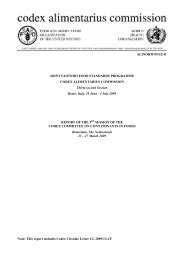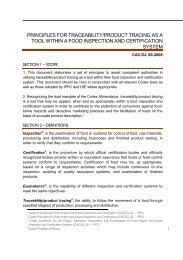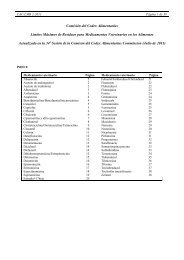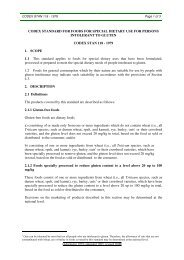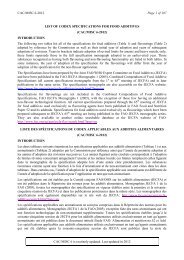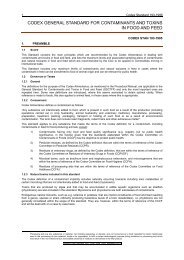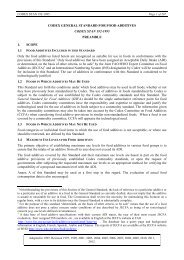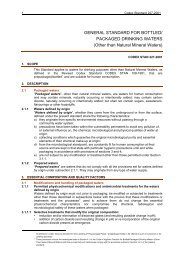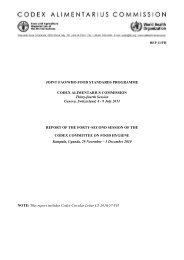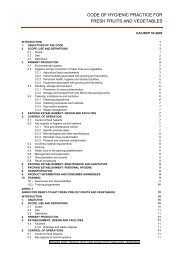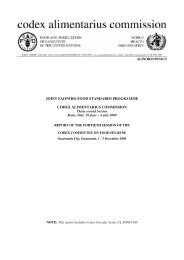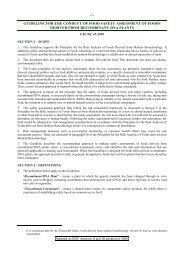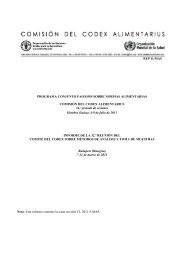proposed draft guidelines for the validation of food safety control
proposed draft guidelines for the validation of food safety control
proposed draft guidelines for the validation of food safety control
Create successful ePaper yourself
Turn your PDF publications into a flip-book with our unique Google optimized e-Paper software.
CAC/GL 69 - 2008 Page 7 <strong>of</strong> 16<br />
Steps Involved in <strong>the</strong> Validation Process<br />
After completing <strong>the</strong> tasks needed prior to <strong>validation</strong>, <strong>the</strong> process <strong>of</strong> validating <strong>control</strong> measures includes <strong>the</strong><br />
following steps:<br />
•<br />
•<br />
•<br />
•<br />
•<br />
•<br />
•<br />
•<br />
•<br />
•<br />
Decide on <strong>the</strong> approach or combination <strong>of</strong> approaches.<br />
Define <strong>the</strong> parameters and decision criteria 10 that will demonstrate that a <strong>control</strong> measure or<br />
combination <strong>of</strong> <strong>control</strong> measures, if properly implemented, is capable <strong>of</strong> consistently <strong>control</strong>ling <strong>the</strong><br />
hazard to <strong>the</strong> specified outcome.<br />
Assemble relevant <strong>validation</strong> in<strong>for</strong>mation and conduct <strong>the</strong> studies where needed.<br />
Analyze <strong>the</strong> results.<br />
Document and review <strong>the</strong> <strong>validation</strong>.<br />
Results <strong>of</strong> a <strong>validation</strong> will ei<strong>the</strong>r demonstrate that a <strong>control</strong> measure or combination <strong>of</strong> <strong>control</strong> measures,<br />
is capable <strong>of</strong> <strong>control</strong>ling <strong>the</strong> hazard to <strong>the</strong> specified outcome if properly implemented, and thus,<br />
could be implemented, or<br />
is not capable <strong>of</strong> <strong>control</strong>ling <strong>the</strong> hazard to <strong>the</strong> specified outcome and should not be implemented.<br />
The latter may lead to re-evaluation <strong>of</strong> product <strong>for</strong>mulation, process parameters, or o<strong>the</strong>r appropriate<br />
decisions/actions.<br />
In<strong>for</strong>mation gained in <strong>the</strong> <strong>validation</strong> process may be useful in designing verification and monitoring<br />
procedures. For example, if a <strong>control</strong> measure or combination <strong>of</strong> <strong>control</strong> measures produces a reduction <strong>of</strong> a<br />
pathogen well in excess <strong>of</strong> <strong>the</strong> reduction needed <strong>for</strong> hazard <strong>control</strong>, it may be possible to decrease <strong>the</strong><br />
frequency <strong>of</strong> verification e.g. frequency <strong>of</strong> microbiological testing <strong>of</strong> end product.<br />
VII. NEED FOR RE-VALIDATION<br />
There are many changes that could lead to a need to re-validate a <strong>control</strong> measure or combination <strong>of</strong> <strong>control</strong><br />
measures. Examples include:<br />
System failure: If monitoring or verification identifies failures <strong>for</strong> which a process deviation cause<br />
cannot be identified, re-<strong>validation</strong> may be needed. Non-compliance with monitoring or verification<br />
criteria may indicate a need <strong>for</strong> a change in <strong>the</strong> parameters (i.e., <strong>the</strong> selection and specification <strong>of</strong> <strong>the</strong><br />
<strong>control</strong> measures) on which <strong>the</strong> design <strong>of</strong> <strong>the</strong> <strong>food</strong> <strong>safety</strong> <strong>control</strong> system is based. A system failure may<br />
also result from an inadequate hazard analysis and may require re-<strong>validation</strong>.<br />
Process changes: The introduction in <strong>the</strong> <strong>food</strong> <strong>safety</strong> <strong>control</strong> system <strong>of</strong> a new <strong>control</strong> measure,<br />
technology or a piece <strong>of</strong> equipment that is likely to have a decisive impact on <strong>the</strong> <strong>control</strong> <strong>of</strong> <strong>the</strong> hazard<br />
may necessitate that <strong>the</strong> system or parts <strong>of</strong> it be re-validated. Similarly, changes made in product<br />
<strong>for</strong>mulation or <strong>the</strong> application <strong>of</strong> current <strong>control</strong> measures (e.g. time/temperature changes) may result in<br />
<strong>the</strong> need <strong>for</strong> re-<strong>validation</strong> <strong>of</strong> <strong>control</strong> measures.<br />
New scientific or regulatory in<strong>for</strong>mation: Re-<strong>validation</strong> may be needed if <strong>the</strong> hazard associated with a<br />
<strong>food</strong> or ingredient changes as a result <strong>of</strong> (i) higher concentrations <strong>of</strong> hazards than originally encountered<br />
and accounted <strong>for</strong> in <strong>the</strong> design, (ii) a change in response <strong>of</strong> a hazard to <strong>control</strong> (e.g. adaptation), (iii)<br />
10 Decision criteria should take into account <strong>the</strong> uncertainty and variability associated with <strong>the</strong> <strong>validation</strong> methodology<br />
and <strong>the</strong> per<strong>for</strong>mance <strong>of</strong> <strong>the</strong> <strong>control</strong> measure or combination <strong>of</strong> <strong>control</strong> measures.



